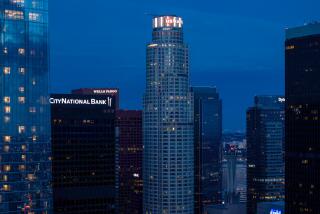Panel to Probe Wall’s Role in Lincoln S&L; Case : Thrifts: Why did regulators wait so long before finally seizing the troubled Irvine firm?
A controversial decision made 2 1/2 years ago by federal thrift regulators in Washington will emerge as a focal point of House Banking Committee hearings that begin today into the failure of Lincoln Savings & Loan in Irvine.
The hearings before the 51-member committee are loaded with political overtones. Committee Chairman Henry B. Gonzalez (D-Tex.) is expected to come out swinging at top regulatory executives appointed by former President Ronald Reagan, who he feels are responsible for Lincoln’s collapse, perhaps the costliest in the nation’s history.
The proceedings also are likely to raise more questions about the actions of five U.S. senators, including California Democrat Alan Cranston, on behalf of Lincoln officials. All five met with regulators concerning Lincoln and received campaign contributions from Phoenix businessman Charles H. Keating Jr.--whose company owned Lincoln--and from his family and associates.
“Our intent is to make this a full record, a major case history, of what went wrong,” said Joseph C. (Jake) Lewis, spokesman for the banking committee.
The only witness today will be L. William Seidman, chairman of the Federal Deposit Insurance Corp., which has managed Lincoln since its takeover. Seidman is expected to play the role of coroner, analyzing the S&L;’s financial condition and explaining its demise.
But the committee is clearly taking aim at another regulator--M. Danny Wall, director of the Office of Thrift Supervision and chairman of its predecessor agency, the Federal Home Loan Bank Board. As head of the thrift industry’s regulatory body, Wall decided to ignore the recommendations of the board’s regional office in California regarding Lincoln.
Federal regulators in San Francisco had decided by May 1, 1987, that they needed to seize Lincoln or otherwise gain control of the thrift’s activities. But since Wall and another appointee of the three-member board were scheduled to take office July 1, no action was taken.
It wasn’t until almost two years later that regulators took over Lincoln, a day after its parent company, American Continental Corp. in Phoenix, had filed for bankruptcy protection. By then, some 22,000 people, mostly elderly Southern Californians, had bought about $200 million in American Continental bonds, which now may be worthless.
Why regulators waited so long before finally seizing Lincoln is what the banking committee hopes to determine in the hearings, which will involve four sessions over three weeks.
“That May, 1987, date was a key one because it was the first time there was a flat finding by regulators” of cause to take action against Lincoln, Lewis said.
Since that date, he said, “there’s been great curiosity” about why the recommendations of the San Francisco regional regulators were never followed, why they were removed from supervising Lincoln and why their unusually long examination of the S&L;’s financial health was thrown out and a new one ordered.
“The committee wants to know what this delay meant ultimately to the (deposit insurance) fund.” Lewis said.
Gonzalez has blamed Wall for “gross mishandling” of the Lincoln case and for unprecedented actions in removing the San Francisco regulators. The delay, he claimed, could cost taxpayers more than $2 billion. Wall has put the cost of Lincoln’s failure at $1.1 billion to $1.5 billion.
A key provision of President Bush’s thrift bailout law was whether Wall would be allowed to continue as the nation’s top thrift regulator. The new law allowed him to remain, much to the dismay of Gonzalez.
“They’re going to fry Wall,” a regulatory official in San Francisco said about the committee hearing. “If Gonzalez doesn’t get him on Lincoln, he’ll get him for all the deals that were done at the end of last year.”
Lawmakers have repeatedly charged that in the so-called December deals, the bank board sold 75 insolvent institutions at fire-sale prices and committed the federal government to honoring $16 billion of insurance fund obligations without proper authority.
Wall said recently that he expects tough questions but that good reasons exist for the actions that the bank board took.
Some analysts think that Wall’s predecessor, former bank board Chairman Edwin Gray, should share the blame.
“Gray ought to get beaten up just as much as Danny has been,” said Bert Ely, an Alexandria, Va., industry consultant. “Gray had the ball and didn’t make the hard decision that he should have, and left it instead to his successor. Ed has since been amazingly successful at rewriting history.”
Gray was once the target of congressional criticism for his seeming inability to stem the flow of S&L; disasters. But Gray defends himself.
Contacted in France, where he is vacationing, Gray said the recommendation to take down Lincoln didn’t reach his desk until about one week before he left office June 30. At that time, he said, it was too late to complete the procedures for seizing Lincoln before his term was up, and the three-member bank board was a member short already.
The new board, however, should have been able to take action with two months, Gray said.
Instead, the board under Wall listened to Keating’s longstanding complaints, found that regulators had leaked information that had damaged Lincoln, suspected that the San Francisco regulators had exacerbated the fractious regulatory relationship with Keating and decided in May, 1988, to remove Lincoln from San Francisco’s supervision and to initiate a new audit with a blue-ribbon panel of experienced examiners.
More to Read
Inside the business of entertainment
The Wide Shot brings you news, analysis and insights on everything from streaming wars to production — and what it all means for the future.
You may occasionally receive promotional content from the Los Angeles Times.










